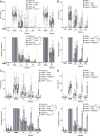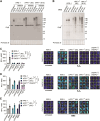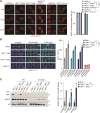Dispensability of HPF1 for cellular removal of DNA single-strand breaks
- PMID: 39162207
- PMCID: PMC11472159
- DOI: 10.1093/nar/gkae708
Dispensability of HPF1 for cellular removal of DNA single-strand breaks
Abstract
In response to DNA damage, the histone PARylation factor 1 (HPF1) regulates PARP1/2 activity, facilitating serine ADP-ribosylation of chromatin-associated factors. While PARP1/2 are known for their role in DNA single-strand break repair (SSBR), the significance of HPF1 in this process remains unclear. Here, we investigated the impact of HPF1 deficiency on cellular survival and SSBR following exposure to various genotoxins. We found that HPF1 loss did not generally increase cellular sensitivity to agents that typically induce DNA single-strand breaks (SSBs) repaired by PARP1. SSBR kinetics in HPF1-deficient cells were largely unaffected, though its absence partially influenced the accumulation of SSB intermediates after exposure to specific genotoxins in certain cell lines, likely due to altered ADP-ribosylation of chromatin. Despite reduced serine mono-ADP-ribosylation, HPF1-deficient cells maintained robust poly-ADP-ribosylation at SSB sites, possibly reflecting PARP1 auto-poly-ADP-ribosylation at non-serine residues. Notably, poly-ADP-ribose chains were sufficient to recruit the DNA repair factor XRCC1, which may explain the relatively normal SSBR capacity in HPF1-deficient cells. These findings suggest that HPF1 and histone serine ADP-ribosylation are largely dispensable for PARP1-dependent SSBR in response to genotoxic stress, highlighting the complexity of mechanisms that maintain genomic stability and chromatin remodeling.
© The Author(s) 2024. Published by Oxford University Press on behalf of Nucleic Acids Research.
Figures






Similar articles
-
HPF1-dependent histone ADP-ribosylation triggers chromatin relaxation to promote the recruitment of repair factors at sites of DNA damage.Nat Struct Mol Biol. 2023 May;30(5):678-691. doi: 10.1038/s41594-023-00977-x. Epub 2023 Apr 27. Nat Struct Mol Biol. 2023. PMID: 37106138
-
The CSB chromatin remodeler regulates PARP1- and PARP2-mediated single-strand break repair at actively transcribed DNA regions.Nucleic Acids Res. 2023 Aug 11;51(14):7342-7356. doi: 10.1093/nar/gkad515. Nucleic Acids Res. 2023. PMID: 37326017 Free PMC article.
-
Dual function of HPF1 in the modulation of PARP1 and PARP2 activities.Commun Biol. 2021 Nov 3;4(1):1259. doi: 10.1038/s42003-021-02780-0. Commun Biol. 2021. PMID: 34732825 Free PMC article.
-
Mechanistic insight into the role of Poly(ADP-ribosyl)ation in DNA topology modulation and response to DNA damage.Mutagenesis. 2020 Feb 13;35(1):107-118. doi: 10.1093/mutage/gez045. Mutagenesis. 2020. PMID: 31782485 Review.
-
Relation between carcinogenesis, chromatin structure and poly(ADP-ribosylation) (review).Anticancer Res. 1991 Mar-Apr;11(2):489-527. Anticancer Res. 1991. PMID: 1905900 Review.
Cited by
-
Joining of DNA breaks- interplay between DNA ligases and poly (ADP-ribose) polymerases.DNA Repair (Amst). 2025 May;149:103843. doi: 10.1016/j.dnarep.2025.103843. Epub 2025 May 2. DNA Repair (Amst). 2025. PMID: 40347914 Review.
-
HPF1 Regulates Pol β Efficiency in Nucleosomes via the Modulation of Total Poly(ADP-Ribose) Synthesis.Int J Mol Sci. 2025 Feb 20;26(5):1794. doi: 10.3390/ijms26051794. Int J Mol Sci. 2025. PMID: 40076422 Free PMC article.
-
Targeting DNA damage sensors for cancer therapy.DNA Repair (Amst). 2025 May;149:103841. doi: 10.1016/j.dnarep.2025.103841. Epub 2025 May 2. DNA Repair (Amst). 2025. PMID: 40339280 Review.
-
FEN1 is critical for rapid single-strand break repair in G1 phase.Nucleic Acids Res. 2025 Jul 19;53(14):gkaf710. doi: 10.1093/nar/gkaf710. Nucleic Acids Res. 2025. PMID: 40694846 Free PMC article.
References
-
- Lindahl T. Instability and decay of the primary structure of DNA. Nature. 1993; 362:709–715. - PubMed
-
- Caldecott K.W. DNA single-strand break repair and human genetic disease. Trends Cell Biol. 2022; 32:733–745. - PubMed
-
- Demple B., Harrison L.. Repair of oxidative damage to DNA: enzymology and biology. Annu. Rev. Biochem. 1994; 63:915–948. - PubMed
-
- Caldecott K.W. Mammalian DNA base excision repair: dancing in the moonlight. DNA Repair (Amst.). 2020; 93:102921. - PubMed
MeSH terms
Substances
Grants and funding
LinkOut - more resources
Full Text Sources
Miscellaneous

